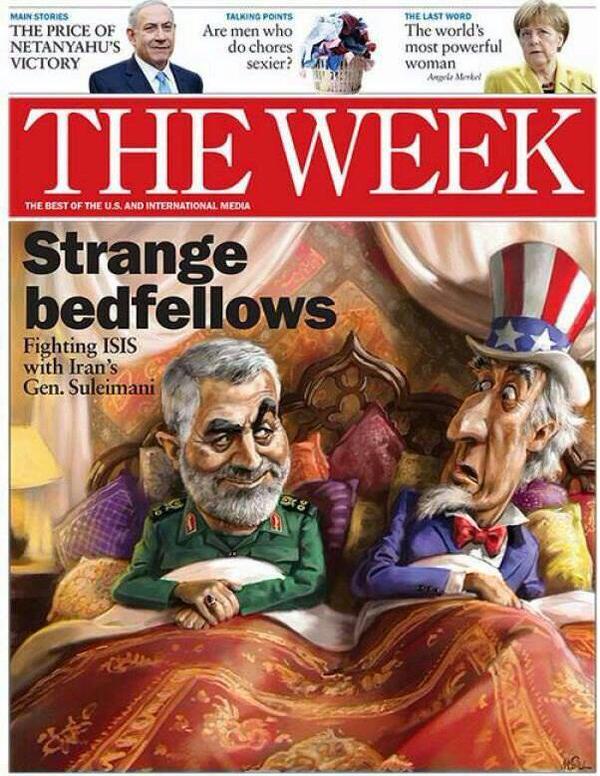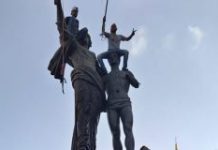Qassem Soleimani and building Iranian character
Wednesday, 25 March 2015
Abdulrahman al-Rashed/Al Arabiya
It is unusual for the Iranian regime to publicize its military and security leaders despite the many wars it has been involved in during the last three decades. This is what makes General Qassim Soleimani, commander of the Quds Force of the Iranian revolutionary Guards, an interesting case. He has received unusual media exposure beyond what’s allowed in the Iranian state-run media and in the Arab media outlets affiliated with Tehran. It’s obvious that the importance of the general stretches beyond his military command position as he leads Iran’s foreign political and military wars. Soleimani’s publicity may be a natural result of Iran’s increasing dependency on its own military power after it had mainly depended on its local proxies, like Hezbollah, the Hamas movement and Iraqi Shiite militias. Soleimani was tasked with a prominent role in Syria and the statement that “if it hadn’t been for Iranian help, the Syrian regime would have collapsed” is no exaggeration.
The Americans say that it’s “he (Soleimani) who’s leading the war in Syria.” As a matter of fact, the regime of Bashar al-Assad tottered for two years and Syrian regime forces were besieged everywhere until they were revived when the Iranians assumed many leadership tasks and brought in, funded and managed tens of thousands of Lebanese Hezbollah fighters, Iraqi Asaa’ib Ahl Al-Haq militants and Shiite Afghans. The Syrian scenario, which Soleimani is leading, is being repeated in Iraq. Hadi al-Amiri, head of the Iraqi Badr organization, was quoted as saying that “if it hadn’t been for Iran’s help and for Soleimani’s presence in Iraq, the government of Haidar al-Abadi would have been outside Iraq now.” There is news that General Soleimani is present with his forces, in a lesser number, in Yemen alongside the Houthi rebels.
Fierce offensive policy
Speaking about Soleimani, David Petraeus, former commander of U.S. troops in Iraq, recently said that in the spring of 2008, Suleimani made it clear to him that he was in charge of Iran’s policy regarding Iraq. It’s obvious that the importance of the general stretches beyond his military command position. This explains Iran’s policy and that it depends on General Soleimani managing conflict zones, like Iraq, Syria and Yemen. And it depends also on him managing political activities, like supporting certain parties over others and achieving results and political decisions which serve the interests of Iran and of those allied with it.
During the past year, it has become clear that the Iranian leadership adopts a fierce offensive policy which could extend beyond its current borders. It’s publicizing its military and security leaderships and presenting them as heroes to the Iranian people and to those allied with Iran. It’s doing so by embellishing a military commander like Soleimani. This style is often used in big wars. Among the stars of World War II are generals whose importance was equal to political leaders. Some examples were British general Montgomery, German general Rommel and American general Patton. General Soleimani has certainly become the most famous Iranian figure in the arena of regional wars. Two years ago, the New Yorker published a report on him as the figure managing Iran’s foreign wars. Sanctions against Soleimani by the U.S. Department of Treasury did not prevent his media appearances, confirming that the Iranian policy has become clearer than before when prominent figures were not allowed to be part of foreign political and military battles. Our region has become full of war generals who decide the region’s fate more than politicians do especially as fronts multiply and circumstances complicate. The frequent question is: how will the war end? I’ll quote what General Petraeus said: “Yes, ‘Hajji Qassem,’ our old friend. I have several thoughts when I see the pictures of him… What I will say is that he is very capable and resourceful individual, a worthy adversary. He has played his hand well. But this is a long game, so let’s see how events transpire.”
سليماني وصناعة الشخصية الإيرانية
عبد الرحمن الراشد/الشرق الأوسط/15 آذار/15
لم يعهد عن النظام الإيراني ترويجه لقياداته العسكرية والأمنية، رغم كثرة الحروب التي انخرط فيها على مدى ثلاثة عقود، وهذا ما يجعل الجنرال قاسم سليماني، قائد فيلق القدس، في الحرس الثوري، حالة لافتة، نظرا للظهور الإعلامي الخارج عن المألوف، ويسمح به في الوسائل الرسمية الإيرانية، والأخرى العربية المحسوبة على طهران. ومن الواضح أن أهمية الجنرال أبعد من مركزه كقائد لفيلق، حيث يقود حروب إيران الخارجية، السياسية والعسكرية.
قد يكون بروزه نتيجة طبيعية لتزايد اعتماد إيران على قوتها العسكرية، بعد أن كانت تتكل بشكل أكبر على دعم وكلائها المحليين، مثل حزب الله وحماس والميليشيات الشيعية العراقية. فقد عُهد إليه بدور كبير في سوريا، وليس مبالغة ما قيل من أنه «لولا النجدة الإيرانية لسقط النظام السوري»، ويقول الأميركيون «إنه من يقود الحرب في سوريا». فقد كان نظام بشار الأسد، بالفعل، يترنح منذ عامين، وحوصرت قواته في كل مكان، ثم عادت إليها الحياة في أعقاب تولي الإيرانيين الكثير من المهام القيادية، وقيامهم بجلب وتمويل وإدارة عشرات الآلاف من لبنانيي حزب الله، وعراقيي «عصائب الحق»، ومن شيعة الأفغان. هذا السيناريو السوري الذي يقوده سليماني يتكرر في العراق، ونسب لرئيس منظمة بدر العراقية، هادي العامري، قوله، «لولا مساندة إيران، ووجود قاسم سليماني في العراق، لكانت حكومة حيدر العبادي الآن خارج العراق». وهناك أنباء أن الجنرال موجود مع قواته، وبعدد أقل، في اليمن في صف المتمردين الحوثيين. قائد القوات الأميركية سابقا في العراق، الجنرال ديفيد بترايوس، تحدث عن سليماني، أنه في عام 2008، وصلته منه رسالة صريحة، بأنه المعني بشأن العراق. وهذا يفسر لنا سياسة إيران، بأنها تعتمد على جنرالها في إدارة مناطق النزاع، مثل العراق وسوريا واليمن، بما في ذلك النشاط السياسي، كتفضيل أحزاب على أخرى، وتأمين النتائج، والقرارات السياسية، لصالح إيران أو من في صفها.
خلال العام الماضي صار واضحا أن القيادة الإيرانية تتبنى سياسة هجومية شرسة، أتوقع أن حدودها أبعد من حدود الخريطة التي تتحرك عليها الآن. وهي تبرز قياداتها الأمنية والعسكرية، كصناعة أبطال يمثلونها في الصورة الذهنية عند الشعب الإيراني، والمتحالفين معه، بتلميع شخصية قيادية عسكرية مثل سليماني. هذا الأسلوب كان يستخدم أكثر في الحروب الكبيرة، فمن بين نجوم الحرب العالمية الثانية جنرالات، يوازنون في أهميتهم الزعماء السياسيين، مثل البريطاني مونتغمري، والألماني رومل، والأميركي باتون. ولا شك أن الجنرال سليماني صار أشهر الإيرانيين على مسرح الحروب الإقليمية. وقد خصصت له مجلة «نيويوركر» قبل سنتين ملفا مهما عن شخصيته، على أنه من يدير حروب إيران الخارجية. ورغم أنه من المحظورين على قائمة وزارة الخزانة الأميركية، فإن ذلك لم يمنع من ظهوره على الإعلام، في تأكيد على أن السياسة الإيرانية صارت أكثر وضوحا مِمّا كانت تفعل في السابق، حيث لم يكن يسمح لكبار الشخصيات أن يكونوا جزءا من المعارك السياسية والعسكرية الخارجية. منطقتنا أصبحت مليئة بجنرالات الحرب، هم الذين يقررون مصيرها أكثر من السياسيين، مع تعدد الجبهات وتعقد الأوضاع. والسؤال المتكرر: كيف للحرب أن تنتهي؟ أستعير ما قاله الجنرال بترايوس: «أجل، حاجي قاسم، صديقنا القديم. تدور الكثير من الأفكار برأسي حينما أشاهد صوره.. ما أود قوله هو أنه يقوم بدوره بمنتهى الفعالية، لكنها لعبة طويلة بالفعل، لذا، دعونا نرى ما تتمخض عنه الأحداث


















